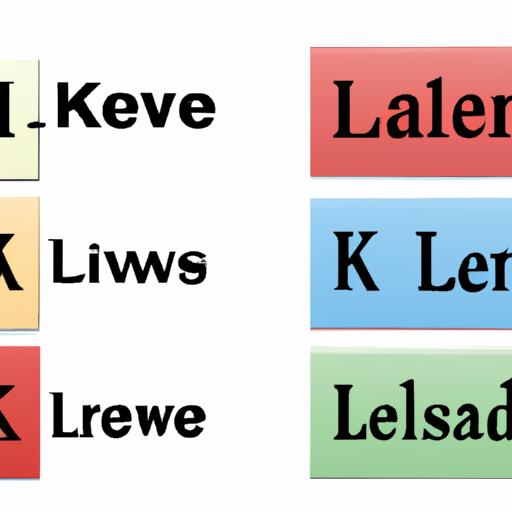Unlock the potential of k level descriptions in education. Learn how they guide curriculum development, aid assessment, and empower teachers and students.
Introduction to K Level Descriptions

Education is a journey of growth and development, but how can we ensure that students progress steadily along the way? This is where K Level Descriptions come into play. In this article, we will delve into the importance and significance of K Level Descriptions in education, exploring how they aid in curriculum development and assessment.
A. Definition and Significance of K Level Descriptions in Education
K Level Descriptions, also known as Knowledge Level Descriptions, provide a comprehensive framework for understanding the expected skills and knowledge at different stages of a student’s education. These descriptions outline the learning outcomes, allowing educators to gauge and measure progress effectively. By providing clear benchmarks, K Level Descriptions empower both teachers and students with a shared understanding of what is expected at each level.
B. Importance of Understanding K Level Descriptions for Teachers and Students
Imagine embarking on a road trip without a map or GPS. It would be challenging to navigate the journey and reach your destination efficiently. Similarly, without an understanding of K Level Descriptions, educators and students may find themselves lost in the educational landscape. By familiarizing themselves with these descriptions, teachers can tailor their instruction to meet the specific needs of their students, ensuring targeted learning experiences that facilitate growth. Likewise, students can take ownership of their learning journey, setting achievable goals and tracking their progress with confidence.
C. How K Level Descriptions Aid in Curriculum Development and Assessment
Curriculum development can be a complex task, requiring careful consideration of learning objectives and outcomes. K Level Descriptions provide a roadmap for educators, guiding them in designing a curriculum that aligns with the expected knowledge and skills at each level. These descriptions help create coherence and consistency across different classrooms and schools, enhancing the quality of education. Additionally, K Level Descriptions play a vital role in assessments, enabling educators to evaluate student performance accurately and provide valuable feedback to support growth.
Now that we have established the importance of K Level Descriptions, let’s explore the different levels and their associated skills and knowledge in the next section.
Understanding the Levels of K Level Descriptions

A. Overview of Different Levels
K Level Descriptions encompass various grade levels, ensuring a comprehensive educational framework for students from kindergarten to high school. These levels are typically categorized as K-5, 6-8, and 9-12, representing different stages of a student’s academic journey. Each level builds upon the previous one, fostering a progressive learning experience.
B. Explanation of the Progression Within Each Level
Within each level, students encounter a gradual progression of skills and knowledge. For instance, in the K-5 level, students begin with foundational concepts and gradually advance to more complex subject matter. This progression ensures a scaffolded learning experience, where students can develop a deep understanding of the content as they move forward.
In the 6-8 level, students further expand their knowledge and skills, preparing them for the challenges of high school. The curriculum becomes more specialized, allowing students to explore different subject areas and develop a well-rounded education.
Finally, in the 9-12 level, students delve into advanced topics and subject-specific domains. This level focuses on preparing students for higher education or entering the workforce, equipping them with the necessary skills to succeed in their chosen paths.
C. Examples of Skills and Knowledge Associated with Each Level
Let’s take a closer look at the skills and knowledge associated with each level of K Level Descriptions:
-
K-5 Level: At this stage, students develop foundational skills such as literacy, numeracy, and basic problem-solving. They learn to read, write, and comprehend texts, perform fundamental mathematical operations, and explore various scientific concepts.
-
6-8 Level: In this phase, students deepen their understanding of core subjects like language arts, mathematics, science, and social studies. They engage in critical thinking, analyze complex texts, solve more intricate mathematical problems, conduct scientific experiments, and explore historical events and cultures.
-
9-12 Level: At the high school level, students delve into advanced coursework tailored to their interests and career aspirations. They engage in advanced literature analysis, tackle complex mathematical concepts, conduct scientific research, and explore specialized subjects like advanced placement courses, foreign languages, or vocational training.
Understanding the progression and the skills associated with each level of K Level Descriptions allows educators to design appropriate curriculum and instruction that supports students’ growth and prepares them for future success. In the next section, we will explore the benefits of utilizing K Level Descriptions in the classroom.
Benefits of Utilizing K Level Descriptions

Education is a dynamic field that constantly evolves to meet the needs of students. Utilizing K Level Descriptions offers numerous benefits that foster effective teaching and learning. Let’s explore some of these advantages below.
A. Clear Communication of Learning Expectations and Goals
Imagine a classroom where students are unsure of what they need to achieve and teachers struggle to articulate their expectations. This lack of clarity can hinder progress and lead to frustration. However, by incorporating K Level Descriptions into the educational framework, communication becomes seamless. These descriptions provide a shared language between teachers, students, and parents, ensuring everyone is on the same page regarding learning expectations and goals. With clear objectives in place, students can better understand what they need to accomplish, fostering a sense of purpose and motivation.
B. Facilitation of Personalized and Differentiated Instruction
Every student is unique, with varying strengths, weaknesses, and learning styles. K Level Descriptions allow for personalized and differentiated instruction, catering to the diverse needs of students. By using these descriptions as a guide, teachers can tailor their lessons to address individual requirements, ensuring that students receive the support and challenges they need to flourish. Whether it’s providing additional resources for struggling students or offering enriched activities for advanced learners, K Level Descriptions promote an inclusive and effective learning environment.
C. Alignment with Standards and Benchmarks
In the realm of education, standards and benchmarks serve as guiding principles, ensuring quality and consistency. K Level Descriptions align seamlessly with these standards, providing a valuable tool for educators to assess and measure student progress accurately. By mapping the skills and knowledge outlined in K Level Descriptions to established standards, teachers can ensure that their instruction aligns with the broader educational goals. This alignment not only enhances the credibility of the educational process but also helps students develop the necessary competencies to succeed in their academic and professional endeavors.
As we have explored the benefits of utilizing K Level Descriptions, it is clear that they play a crucial role in fostering effective communication, personalized instruction, and alignment with educational standards. In the next section, we will discuss practical strategies for implementing K Level Descriptions in the classroom.
Implementing K Level Descriptions in the Classroom
As educators, it is crucial to bridge the gap between theory and practice by effectively implementing K Level Descriptions in our classrooms. In this section, we will explore practical strategies for incorporating these descriptions into lesson planning, adapting instructional materials, and monitoring student progress.
A. Strategies for Incorporating K Level Descriptions into Lesson Planning
Integrating K Level Descriptions into lesson planning ensures that instruction is aligned with the desired learning outcomes. Begin by reviewing the K Level Descriptions for the specific grade level you are teaching. Identify the key skills and knowledge that students should acquire, and then design learning activities that target these areas. By explicitly connecting your lessons to the K Level Descriptions, you provide students with a clear roadmap for their learning journey.
Consider incorporating formative assessments throughout your lessons to gauge student understanding and progress. These assessments can take the form of quizzes, group discussions, or hands-on activities. Analyze the results to identify areas where students may need additional support or enrichment, and adjust your lessons accordingly. By continuously aligning your instruction with the K Level Descriptions, you ensure that students are on track to meet the expected learning outcomes.
B. Adapting Instructional Materials to Align with K Level Descriptions
To effectively implement K Level Descriptions, it is essential to evaluate and adapt instructional materials to align with the expected skills and knowledge. Review your existing resources and identify areas where they align with the K Level Descriptions and where modifications may be necessary. Look for materials that provide opportunities for students to practice and apply the targeted skills. Consider integrating technology, hands-on activities, or real-world examples to enhance engagement and relevance.
Collaborate with colleagues and leverage professional development opportunities to access a variety of instructional materials that align with the K Level Descriptions. Share best practices, exchange resources, and explore new pedagogical approaches together. By adapting and diversifying your instructional materials, you provide students with multiple avenues to engage with the content and meet the desired learning outcomes.
C. Monitoring and Assessing Student Progress using K Level Descriptions
Monitoring student progress is essential to ensure that they are meeting the expected learning outcomes. Regularly assess student performance using assessments aligned with the K Level Descriptions. These assessments can be formative or summative, providing both immediate feedback and a comprehensive evaluation of student growth.
Use the data collected from assessments to inform your instructional decisions. Identify areas of strength and areas where students may need additional support. Provide targeted interventions or enrichment opportunities based on individual student needs. By closely monitoring student progress using the K Level Descriptions, you can personalize instruction and foster a supportive learning environment.
In the next section, we will address the challenges and limitations that may arise when implementing K Level Descriptions in the classroom.
Addressing Challenges and Limitations with K Level Descriptions
Education is a dynamic field, and implementing any new framework comes with its own set of challenges. K Level Descriptions, despite their numerous benefits, are no exception. In this section, we will explore the potential obstacles that educators may face when implementing K Level Descriptions, discuss strategies for overcoming these challenges, and recognize areas for improvement.
A. Identifying Potential Obstacles in Implementing K Level Descriptions
Change can be met with resistance, and introducing K Level Descriptions into an educational setting may encounter some obstacles. One common challenge is the lack of awareness and understanding among educators. It is crucial to provide comprehensive training and support to ensure that teachers are equipped with the knowledge and skills to effectively utilize K Level Descriptions. Additionally, time constraints and workload pressures can hinder the successful implementation of these descriptions. Finding ways to integrate K Level Descriptions seamlessly into existing curriculum and instructional practices is essential.
B. Strategies for Overcoming Challenges in Utilizing K Level Descriptions
To overcome these challenges, collaboration and open communication are key. Establishing professional learning communities where educators can share experiences and best practices can foster a supportive environment for implementing K Level Descriptions. Providing ongoing professional development opportunities and resources can enhance educators’ understanding and confidence in using these descriptions effectively. Furthermore, incorporating K Level Descriptions into professional evaluation systems can incentivize and motivate educators to embrace this framework.
C. Recognizing the Limitations and Potential Areas for Improvement
While K Level Descriptions offer valuable guidance, it is essential to recognize their limitations. They should not be seen as rigid constraints but rather as flexible tools that allow for individualized instruction and unique learning pathways. Continual research and feedback from educators, students, and other stakeholders are crucial to refine and improve K Level Descriptions over time. This iterative process will ensure that the descriptions remain relevant, responsive, and adaptable to the ever-evolving educational landscape.
As we understand and address the challenges and limitations associated with K Level Descriptions, we can move closer to maximizing their potential and reaping the benefits they offer. In the next section, we will explore the future of K Level Descriptions and the possibilities that lie ahead.


